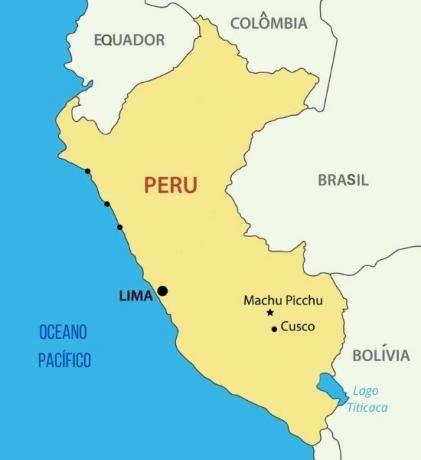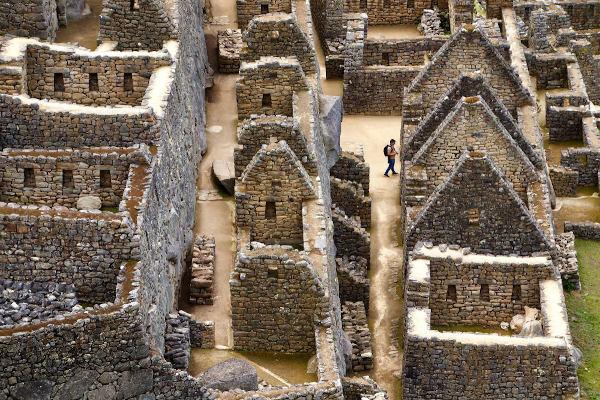machu picchu is an ancient Inca city located in the mountains of Peru, northwest of the city of Cusco. considered one of Seven Wonders of the Modern World and World Heritage Site, Machu Picchu preserves an important chapter in the history of America pre-Columbian, representing a record of the architecture and engineering techniques of the Inca Empire dating back to of the 15th century. The site is currently one of the main tourist destinations in South America and has become a symbol of the subcontinent.
Read too: Aztecs — other peoples who inhabited America before Europeans arrived
Summary about Machu Picchu
Machu Picchu is located in Wmountain range of the Andes, in Peru, near the city of Cusco.
It was built by inca civilization in the 15th century and abandoned around the 16th century.
It is made up of temples, astronomical observatories, palaces, silos, terraces and trails built with rock blocks.
It became known worldwide from 1911, after the expedition of Hiram Bingham.
It features hundreds of preserved structures that show how the society that lived there functioned, its territorial organization and the activities carried out.
It is the main tourist destination in Peru.
One of the most sought after activities by visitors is the Inca Trail, which connects Cusco to Machu Picchu, passing through other historic ruins of the Incas.
In order to keep the historical site and its biodiversity preserved, the number of visitors was limited to 2500 per day.
Location of Machu Picchu
The historic site of Machu Picchu is located in the southeast of Peru, at the south american subcontinent. The city was built at an altitude of 2445 meters in the Vilcabamba mountain range, being described by Unesco as a meeting point between the Peruvian portion of the Andes and the Amazon Basin.

Close to the ruins of Machu Picchu is the Alto Urubamba Valley, where the Urubamba River flows, whose waters supplied most of the Inca cities. As you can see on the map, Machu Picchu is located northwest of Cusco, an important city that played the role of capital of the Inca Empire and is now known as the Archaeological Capital of the Americas.
See too: What are the Seven Wonders of the Ancient World?
History of Machu Picchu
Machu Picchu is a ancient city built bys incas in the 15th century high in the Andes Mountains in the Peruvian province of Urubamba. The set currently occupies an area of 32,592 hectares, which is equivalent to 325.92 km², distributed about two mountain peaks: Machu Picchu (which means Old Mountain or Old Peak) and Huayna Picchu (New Mountain or New Peak).
The ruins of the city are composed of about 200 rock structures, mostly built in granite, which resisted time (chronological) and weather conditions for centuries. These structures (temples, palaces, warehouses) were used for different purposes, among which are: ceremonies and religious rites, development of agricultural practices and as astronomical observation centers.
Connecting these sites are bridges, terraces and trails also built with rocks, which makes Machu Picchu one of the most impressive structures in the world. America pre-Columbian. the city is situated in a mountainous region of climate Pleasant, with temperatures that vary between 20 °C and 1 °C during the year and high rainfall, exceeding 2000 mm per year.
Both its position and disposition, however, provide for the existence of a series of local microclimates. The site of Machu Picchu also has a wide biodiversity, which contains species of animals and plants characteristic of the Andes region and amazon.
→ Inca civilization at Machu Picchu
The construction of Machu Picchu dates from the period of full Expansion of the Inca Empire through the territories of South America. It is worth remembering that the Incas were one of the most important civilizations of pre-Columbian America, which developed in the region of Cusco, where the ruins of Machu Picchu are located. It is estimated that the city was established there in the 15th century, during the reign of Sapa (or Emperor) Pachacutec, who ruled between 1438 and 1471.
It was the conquest of new territories promoted by Pachacútec that made it important to build a fortress that would serve as a refuge for the population Inca who lived in the Cusco valley, especially for members of the nobility and priests. In this way, the city of Machu Picchu housed a small population formed by 500 to 750 inhabitants.
Archaeological evidence, such as pottery-made utensils, indicates, however, that the Incas were not the only residents of Machu Picchu. People from other regions of the country, such as the coast, may also have lived in the city.|1| It is still not known for sure why Machu Picchu was suddenly abandoned by the Incas, although many hypotheses point to the spanish colonization from the 16th century as the main reason.
Machu Picchu was, until then, an isolated city and that only those who knew it, in fact, would know how to access it. Your rediscovery, so to speak, happened justin 1911. It was on July 24 of that year that the American archaeologist, professor and explorer Hiram Bingham arrived at the citadel while searching for the ruins of Vilcabamba, one of the last to resist colonization European. He was responsible for the wide dissemination of Machu Picchu, as there are indications that other explorers arrived there before Bingham.|2|

Machu Picchu Inca Trail
The Incas were responsible for building an extensive road network named qhapaq ñan (“king's way” in the Quechua language) and whose main objective was the territorial integration of the Inca Empire, creating a means of easy access to its then capital, Cusco. In this network it is possible to walk a series of different trails through the historical sites of the Incas.
It's called the Inca Trail roads that connect the city of Cusco The machu picchu. It is a 43-kilometer journey, commonly done on foot, which lasts approximately three to four days. That is one of the main attractions attractions in the region, bearing in mind that the Inca Trail extends through an area where there are other ruins of Inca citadels, in addition to the natural landscape composed by forests and the Andes Mountains.
Know more: How are archaeological sites found?
How important is Machu Picchu?

Most of the city of Machu Picchu is preserved, that is, it has undergone few changes over the more than 500 years of its existence. The fortress represents an important phase in the history of the South American continent, which is the period before European colonization. Machu Picchu also reveals the technical advances in engineering and architecture of one of the main civilizations of pre-Columbian America, which makes the city an important historical and archaeological.
According to Unesco, understand how Inca society worked and the territorial division of its tasks are still some of the information that can be deduced from the structure of Machu Picchu and that reinforce the importance of this place.
Tourism in Machu Picchu
Machu Picchu is the Peru's top tourist destination and one of the most visited in South America. The activity gained strength in the region from the 1990s onwards, reaching a peak of 1.5 million visitors in a single year in the last decade.
The city was declared a Historic Sanctuary by the Peruvian government in 1981, and is still consideredThe heritage of humanity by the Unesco. For this reason, in order to preserve both the structure of the city and the biodiversity that lives there, the number of visitors was recently limited to 2500 people per day. In addition, it is mandatory to accompany a tour guide.
Facts about Machu Picchu
It is one of the Seven Wonders of the Modern World.
It has been listed by Unesco as cultural heritageral and Natural Humanity in 1983.
A flora of Machu Picchu includes 370 species of orchids, 20% of all species found in Peru.
It had a single narrow entrance that required a few soldiers to watch. This characteristic, combined with the relative physical isolation of Machu Picchu, made invading the citadel a very difficult task.
A portion of the original city of Machu Picchu was completely covered by vegetation.
Since 2006 it is forbidden to fly over Machu Picchu. The measure was officially adopted by the Peruvian government and consists of a way to preserve this important historic site.
Grades
|1| HEARN, Kelly; GOLOMB, Jason. Machu Picchu 101. National Geographic, [S.I.]. Available here.
|2| Idem.
image credit
[1] Shutterstock
By Paloma Guitarrara
Geography Teacher
Source: Brazil School - https://brasilescola.uol.com.br/geografia/machu-picchu.htm

